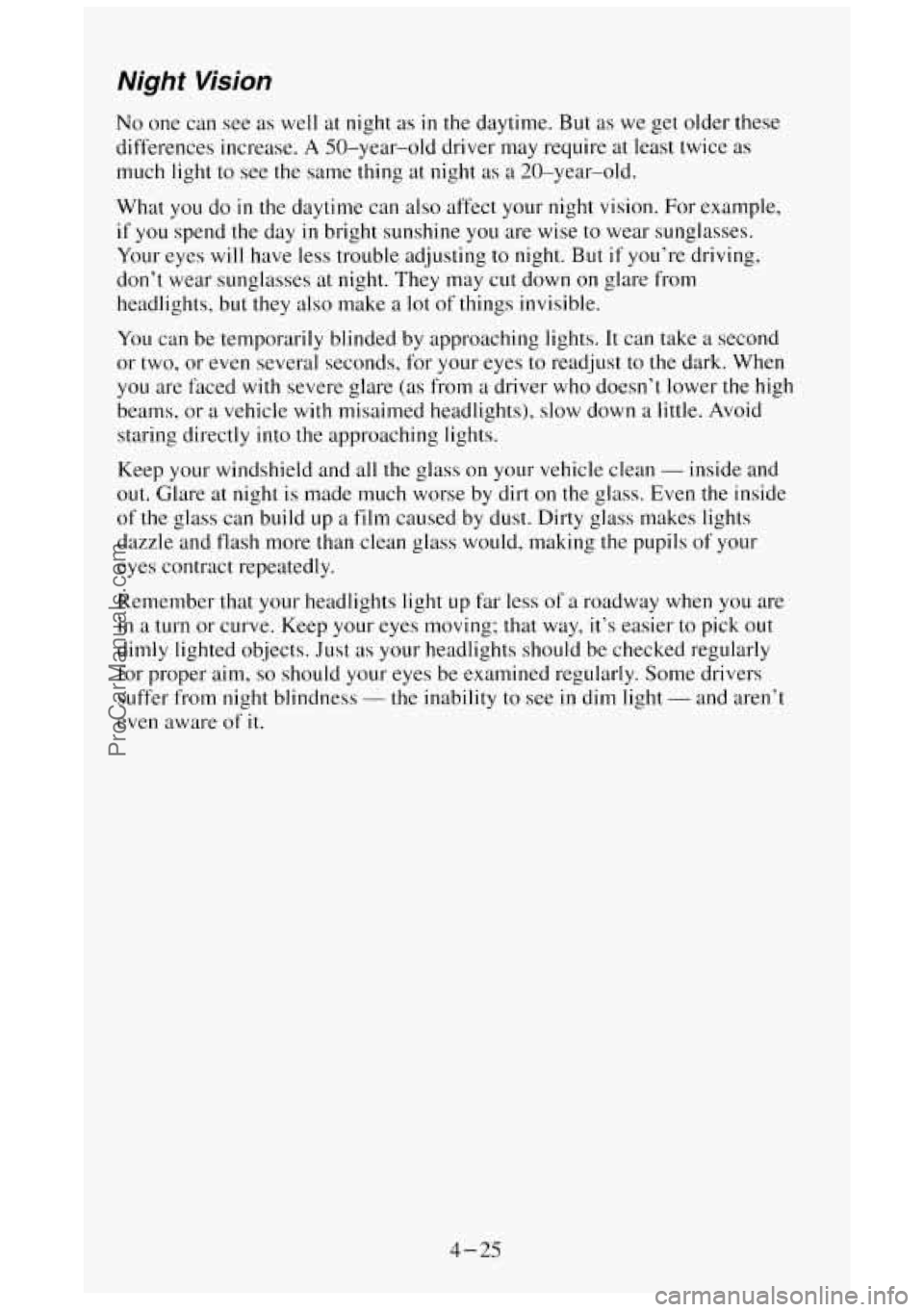Page 188 of 404

After Off-Road Driving
Remove any brush or debris that has collected on the underbody, chassis or
under the hood. These accumulations can be
a fire hazard.
After operation
in mud or sand, have the brake linings cleaned and checked.
These substances can cause glazing and uneven braking. Check the body
structure, steering, suspension, wheels, tires, and exhaust system for
damage. Also, check the fuel lines and cooling system for any leakage.
Your vehicle will require more frequent service due to off-road use. Refer
to the Maintenance Schedule for additional information.
Driving at Night
Night driving is more dangerous than day driving. One reason is that some
drivers are likely to be impaired
- by alcohol or drugs. with night vision
problems,
or by fatigue.
Here are some tips
on night driving.
Drive defensively.
Don’t drink and drive.
a Adjust your inside rearview mirror to reduce the glare from headlights
behind you.
Since you can’t see as well, you may need to slow down and keep more
space between you and other vehicles.
Slow down, especially on higher speed roads. Your headlights can light
up only so much road ahead.
In remote areas, watch for animals.
If you’re tired, pull off the road in a safe place and rest.
4-24
ProCarManuals.com
Page 189 of 404

Nighf Vision
No one can see as well at night as in the daytime. But as we get older these
differences increase. A 50-year-old driver may require at least twice as
much light to see the same thing at night as a 20-year-old.
What
you do in the daytime can also affect your night vision. For example,
if you spend the day in bright sunshine you are wise to wear sunglasses.
Your eyes
will have less trouble adjusting to night. But if you’re driving,
don’t wear sunglasses at night. They may cut down
on glare from
headlights, but they also make a lot of things invisible.
You can be temporarily blinded by approaching lights. It can take a second
or two, or even several seconds, for your eyes
to readjust to the dark. When
you are faced with severe glare (,as from a driver
who doesn’t lower the high
beams,
or a vehicle with misairned headlights), slow down a little. Avoid
staring directly into the approaching lights.
Keep your windshield and all the glass on your vehicle clean
- inside and
out. Glare at night is made much worse by dirt
on the glass. Even the inside
of the glass can build up a film caused by dust. Dirty glass makes lights
dazzle and flash more than clean glass would, making
the pupils of your
eyes contract repeatedly.
Remember that
your headlights light up fir less of a roadway when you are
in a turn or curve. Keep your eyes moving; that way, it’s easier to pick out
dimly lighted objects. Just
as your headlights should be checked regularly
for proper aim,
so should your eyes be examined regularly. Some drivers
suffer from night blindness
- the inability to see in dim light - and aren’t
even aware
of it.
4-25
ProCarManuals.com
Page 395 of 404

Driving (continued) AtNight
............................................... 4-24. 4.38
BackingUp
.................................................. 4-42
Defensive
.................................................... 4-2
Downhill
.................................................... 4-19
Freeway
...................................................... 4-29
Highway Hypnosis
............................................ 4-30
Hydroplaning
................................................ 4-27
InBlizzard
................................................... 4-35
InCity
...................................................... 4-28
InRain
...................................................... 4-26
In Sand, Mud, Ice, Or Snow
........................... 2-15,4-22, 5-40
InWater
..................................................... 4-23
Nightvision
................................................. 4-25
Off-Roading
................................................. 4-13
OnGrades
................................................... 4-43
On Hill and Mountain Roads .................................... 4-31
On Off-Road Hills
............................................ 4-16
On Snow or Ice
..................................... 2-15,433, 4-55
Skidding
.................................................... 4-12
Stuck in Deep Snow
...................................... 4-40, 5-40
Throughwater
.......................................... 2-15, 4-23
Uphill
...................................................... 4-17
Winter
...................................................... 4-33
WithaTrailer
................................................ 4-41
DrunkenDriving ................................................. 4-2
E
Electronic Heating/Air Conditioning (See “Heating”) Engine Adding Coolant
..................................... 5.14.5.17. 6-41
Coolant (Block) Heater
................................ 2.19.3-4. 6.23
Cold Weather Starting (Diesel)
................................... 2-17
Coolant
...................................... 5.13.5.20.6-92. 6.98
Coolant Temperature Gage
...................................... 2-79
Diesel
.................................................. 2.16. 6-5
Crankcase .............................................. 2.96. 6.93
Exhaust
................................................ 2.33. 6.64
FanNoise
................................................... 5-25
Identification
................................................. 6-89
Oil (See “Oil”)
RunningWhileParked
......................................... 2-33
Aircleaner
.................................................. 6-29
Noise Control System
.......................................... 6-16
Overheating
.................................................. 5-11
starting ................................................ 2.12. 2.16
Equipment. Add-on
............................................. 6-68
Exhaustsystem
............................................ 2.33. 6-64
3
ProCarManuals.com